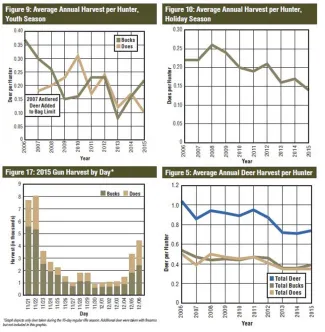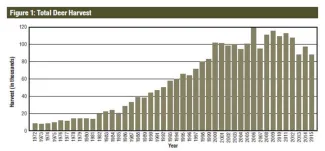
The 2015-16 deer seasons are in the books, and many Oklahoma hunters are already directing their thoughts toward the upcoming seasons. While harvest was more than 8,000 fewer deer than the previous year, the good news is that Oklahoma’s deer herd is in great shape. Many portions of the state have received much-needed rainfall and are on the way to a full recovery from the drought. Hopefully the rains will continue, your treestands are hung, and you are ready for opening day!
Oklahoma hunters took home 88,467 deer (includes white-tailed deer and mule deer) in the 2015-16 deer seasons. This was 8,798 fewer deer than were taken in the 2014-15 seasons. In Figure 1, you can graphically see Oklahoma’s total deer harvest since 1972. Figure 2 shows how many bucks (including button bucks) were killed — 53,327 — which made up 60 percent of the harvest. Doe harvest was 35,140, making up 40 percent of the total harvest.
Deer hunting with a gun continued to be the favorite method of harvest for hunters in Oklahoma as 58 percent of the deer were taken with a modern firearm. When all gun seasons were combined (16-day gun, youth and holiday antlerless), hunters killed 51,119 deer in 2015. Muzzleloader deer hunters contributed 13,998 deer to the total. Again, archery hunters killed more deer than muzzleloader hunters and added 23,350 deer to the overall total harvest in 2015- 16. To see the individual seasons and their respective harvest, look at Figure 3.
Table 1 shows a list of deer harvest by county. Harvest is not equal across counties. This is influenced by the size of the county, the amount of suitable deer habitat, hunter access and many other factors. Some counties have a Wildlife Management Area (WMA) and some do not. To help even the playing field, Table 1 reflects deer harvest totals with the WMAs removed. As always, big counties top the list. Osage County, among the state’s largest, tops the list again in 2015-16, with 4,317 deer harvested. McCurtain County came in second with 2,650. In third was Pushmataha County with 2,465.
With little of Oklahoma in prime mule deer country, harvest is much lower than our neighboring states to the west. However, hunters still get a chance at a mixed bag if they hunt in Oklahoma’s western prairie counties. One county leads the list annually: Cimarron County. It is no surprise that county tops the list for mule deer harvest with 75 in 2015. In second place was Beaver County, with 33; third was Texas County, with 31; fourth was Harper County, with 17; and rounding out the Top 5 is Woodward County, with six. Seventeen of the 77 counties in Oklahoma recorded “mulies” in their harvest total this past year. The remaining 12 counties are Beckham and Ellis (five each), Roger Mills (four), two each in Dewey and Harmon, and one each for Canadian, Custer, Greer, Tillman and Woods counties. All told, 185 of these western deer were harvested in Oklahoma in 2015.
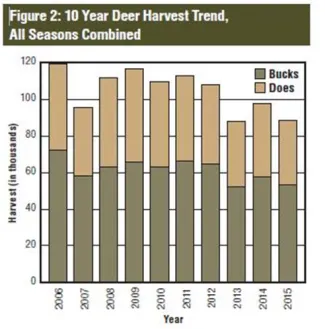
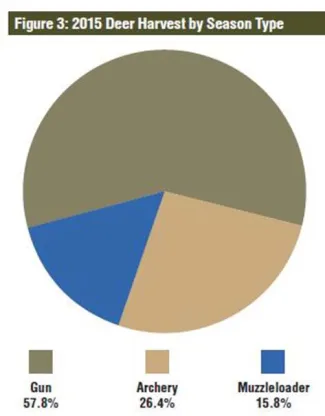
Oklahoma is among the most ecologically diverse states in the nation with 12 different ecoregions found within its borders. It is safe to say with that level of diversity, a “one-size-fits all” approach to managing wildlife is not possible. For this and many other reasons, we section the state into 10 separate management zones (Figure 4). These areas of similar herd and habitat variables are factored in before setting regulations. Even with the differences between the 10 separate zones, they are all managed with a continued emphasis on achieving and maintaining an adequate harvest of antlerless deer to balance the herd with the habitat conditions found within each zone.
All of Oklahoma is open to antlerless deer harvest to one degree or another. Some areas had liberal “doe days,” while others offered a more conservative approach. Depending on the management zone, hunters had the chance to harvest antlerless deer during archery, muzzleloader and modern gun seasons. Again in December 2015, a holiday antlerless season was offered to all hunters willing to hunt in one of the open zones.
In the 2015-16 season, 36,972 antlerless deer (including button bucks) were taken in Oklahoma, making up 42 percent of the harvest. This was 5,093 fewer deer than the 2014-15 total. However, it is important to note that antlerless harvest has been above 40 percent for the past eight years. Hunting remains the single best method available for managing population growth, maintaining healthy buck-to-doe ratios, and safeguarding herd health and habitat health.
The combined season limit for all deer was no more than six deer per individual. Of the six deer allowed, no more than two of them could be antlered bucks. Any deer taken by hunters participating in the holiday antlerless season or deer taken through the Wildlife Department’s Controlled Hunts program were considered “bonus deer” and did not count toward the hunter’s season limit of six deer.


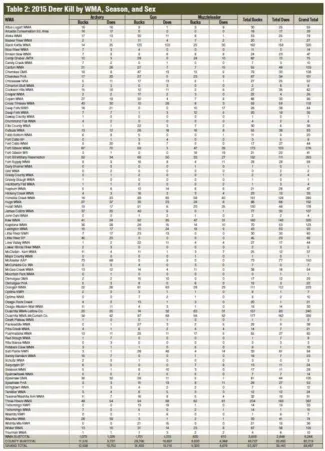
Deer Archery Season
According to the Game Harvest Survey, archery hunters set a participation record for the third year running with 99,069 hunters. Even with 2,168 more hunters afield with archery equipment than in the 2014-15 season, harvest was down 2,391 deer for a total of 23,350 for the 2015-16 season. This trend can be seen in Figure 11, while Figure 12 shows the buck and doe harvest for each week of the archery season. Figure 13 shows the percent success by season type. Archery hunters had a lower success rate than the previous year at 24 percent this past season. The average individual archer’s harvest rate is shown in Figure 6.
Archery season opened Oct. 1 and ran uninterrupted until Jan. 15. The bag limit was six deer, which could include no more than 2 bucks. Figure 3 shows that archery kills made up 26.4 percent of the total harvest.

Deer Muzzleloader Season
Oct. 24 was the start of the 2015 statewide muzzleloader season, and it continued for nine days ending Nov. 1. According to the GHS, the 2015 season saw an increase in participation by 952 hunters for a total of 81,318 muzzleloader hunters in the field (Figure 14). Even with a few more hunters afield this year, harvest was down slightly; 834 fewer deer were harvested for a total of 13,998 deer taken with a muzzleloader. Figure 3 shows that muzzleloader kills made up 15.8 percent of the total harvest.
Muzzleloader hunters had a 17 percent success rate in 2015 (Figure 13). The average individual muzzleloader success rate is shown in Figure 7. The bag limit remained unchanged from 2014. Hunters could harvest one antlered deer and two antlerless deer, provided at least one of the antlerless deer was taken from Management Zone 2, 7, or 8. Figure 15 charts the muzzleloader harvest by day and sex.
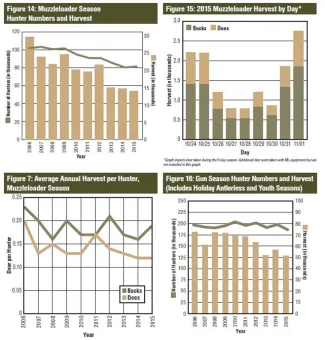
Deer Gun Season
Modern gun season is the perennial favorite of Oklahoma deer hunters. According to the GHS, 186,173 hunters went afield with a rifle. This was 11,539 fewer than last year. Harvest during the 16-day gun season was 51,119, down 5,573 from 2014 (Figure 16). Figure 13 shows gun hunter success rate was down 2 percent this year at 27 percent.
Thanks to youth deer season, younger hunters were the first group to pursue deer with a gun. According to the GHS, 5,361 youths under 18 were hunting Oct. 16-18. Even with 3,000 fewer youth hunters compared to last year, harvest was only short of last year’s harvest by 484 deer, with 3,645 deer taken in three days. This was balanced by their impressive success rate of 68 percent, proving again that seasoned hunters are “passing it on” by helping our next generation of hunters be successful. See Figure 9 to see the youth hunting trend.
The regular 16-day gun season opened Nov. 21, the Saturday before Thanksgiving, and continued through Dec. 6. The GHS indicated that 145,934 sportsmen and sportswomen hunted during those 16 days. On opening weekend, 36 percent of the regular gun season total harvest of 43,848 fell, making it the busiest weekend for deer hunters in the state (Figure 17). Bag limits remained unchanged from the 2014 season with hunters having the chance to harvest three deer, with no more than one antlered and two antlerless per hunter. If taking two antlerless, one had to come from Management Zones 2, 7, or 8.
Eight of the 10 management zones were open for holiday deer gun season at the end of year. Hunters were allowed one last chance to use a modern gun to put meat in the freezer from Dec. 18-27. The 2015 season saw 34,878 hunters taking advantage of the holiday season. The bag limit remained at one antlerless deer. As an added incentive to participate in this season, these deer did not count against hunters’ combined season bag limit of six deer. Figure 10 illustrates the average annual harvest for hunters participating in this popular season.
